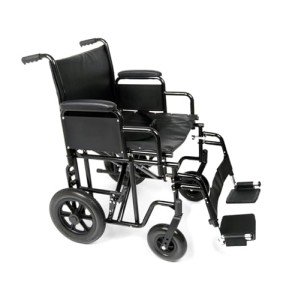Bariatric Wheelchair Seat Width
Seat Width
Having the right seat width is necessary to wheelchair users who spend longer durations in their chairs. Too narrow a seat will cause pressure on the hips and thighs which might result in sores or pressure points. Having too large a seat can likewise make it hard for the user to reach the hand rims to move themselves or maneuver in little areas.
To measure the correct seat width a person would sit on a chair usually and have their measurement taken throughout their lap at the widest point which is normally their hips. A wheelchair measuring tape can be used to determine this, but a backyard stick is chosen as it prevents people from covering the tape around their hips which would provide an unreliable result.

The basic wheelchair seat width is 16" (narrow adult), 18" (basic adult), and 20" (large adult). For bariatric patients, a 24" seat is offered. This heavy-duty additional broad bariatric wheelchair from Medline includes swing-away footrests, a carbon steel frame with rust- and chip-resistant chrome plating, and easy-to-clean vinyl upholstery. It has a weight capacity of 500 pounds.
Seat Depth
Typically, the seat depth of a bariatric wheelchair was included 2" to the measurement taken at the user's best point (normally their hips). This was meant to accommodate additional layers of clothing that may be used throughout winter. However, this practice is becoming less common as wheelchair users are able to spend more time indoors and are not using long coats. This makes the seat depth of a chair lesser when selecting a bariatric wheelchair. However, it is still crucial to choose an alternative that uses appropriate assistance for larger users.
The Medline folding additional wide bariatric manual wheelchair includes a comfortable 24" seat width and a durable slide tube silver vein frame. It also has an adjustable axle and tool-free raising legrests.
Seat Height
When it comes to identifying the appropriate wheelchair seat width you ought to constantly determine from the user's largest point which is usually their hips. You will likewise require to consider whether the user is going to be using a winter season coat as this may add 2" to the width needed.
When a wheelchair is in usage it need to just be operated on level surface areas with the wheel locks fully engaged. This is to avoid the chair from having the ability to move slopes that are 10 degrees or higher. It is also crucial to keep in mind that any activity that might shift the center of mass in the chair need to be made with care. This includes grabbing products that require the individual to lean out of their seat or trying to stand up from it.
Whenever you have the chair in usage it is recommended that you frequently examine it for damage and lubricate any locations that are considered essential. For instance, the casters should be oiled by eliminating the caster fork and using a multi-purpose grease to apply to the caster stem bearings. Similarly, the foot plates can be changed by loosening up the bolt and then moving them to the desired position. This permits the feet to sit conveniently on the footplate and avoids any pressure points from forming. This can be really unpleasant for the user and if left unattended, can lead to press sores.
Weight Capacity
Bariatric wheelchairs are created to support more weight than basic wheelchairs. bariatric electric wheelchairs for sale makes them stronger and better geared up to handle falls. They are likewise usually larger and broader, making them less maneuverable in tight spaces than basic wheelchairs. They need lorries with special ramps and lifts to load them, as well as motorists who understand how to finest transport them from one area to the next.
When selecting a wheelchair, consider its weight capacity as it will be the main determining consider whether it will accommodate your passenger's requirements. The weight capacity of the chair is often noted as a fixed load, indicating that it shows the quantity of weight the chair can conveniently hold while stalling. However, some producers also note an active load that is based upon a drop test and can mimic the result of somebody taking a seat in the chair. This might be a more trustworthy measurement of the weight limit, depending on your needs.
If you prepare to perform activities that shift your center of gravity in the seat (such as grabbing items), make sure to have front casters pointed in a forward direction and wheel locks engaged so the chair will not tip over. Also, inspect that casters are oiled routinely to prevent excessive wear and abrasions. The lubrication procedure involves eliminating the fork, separating the caster from the wheel, and greasing the caster stem bearings with premium multi-purpose grease.
